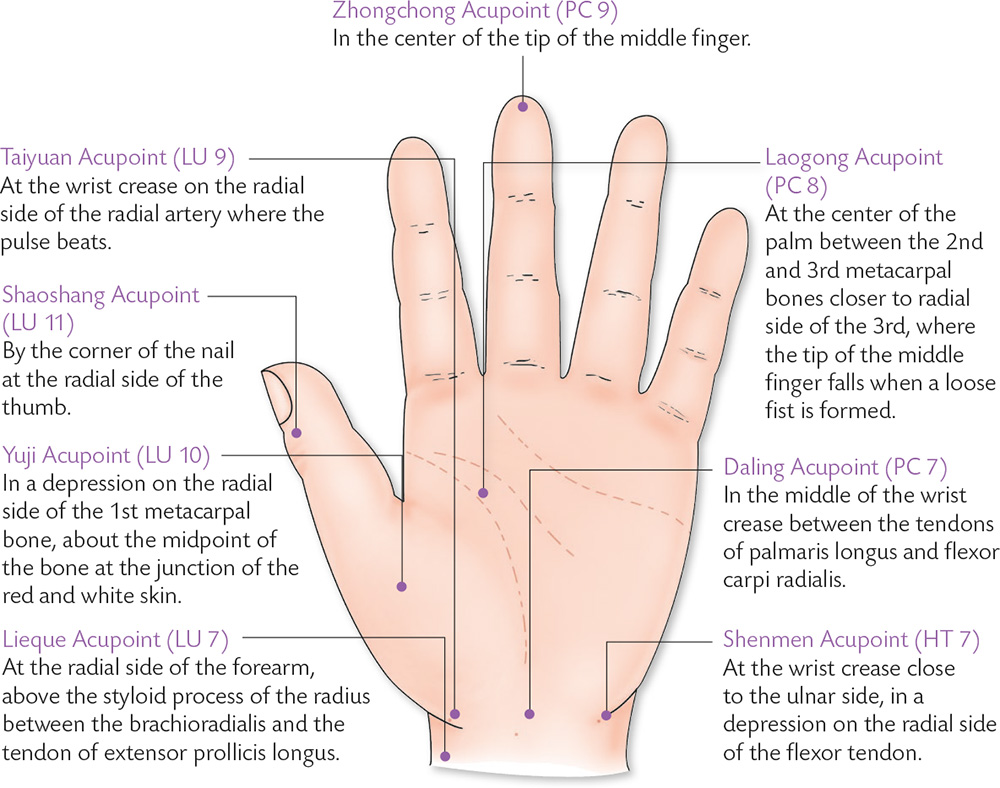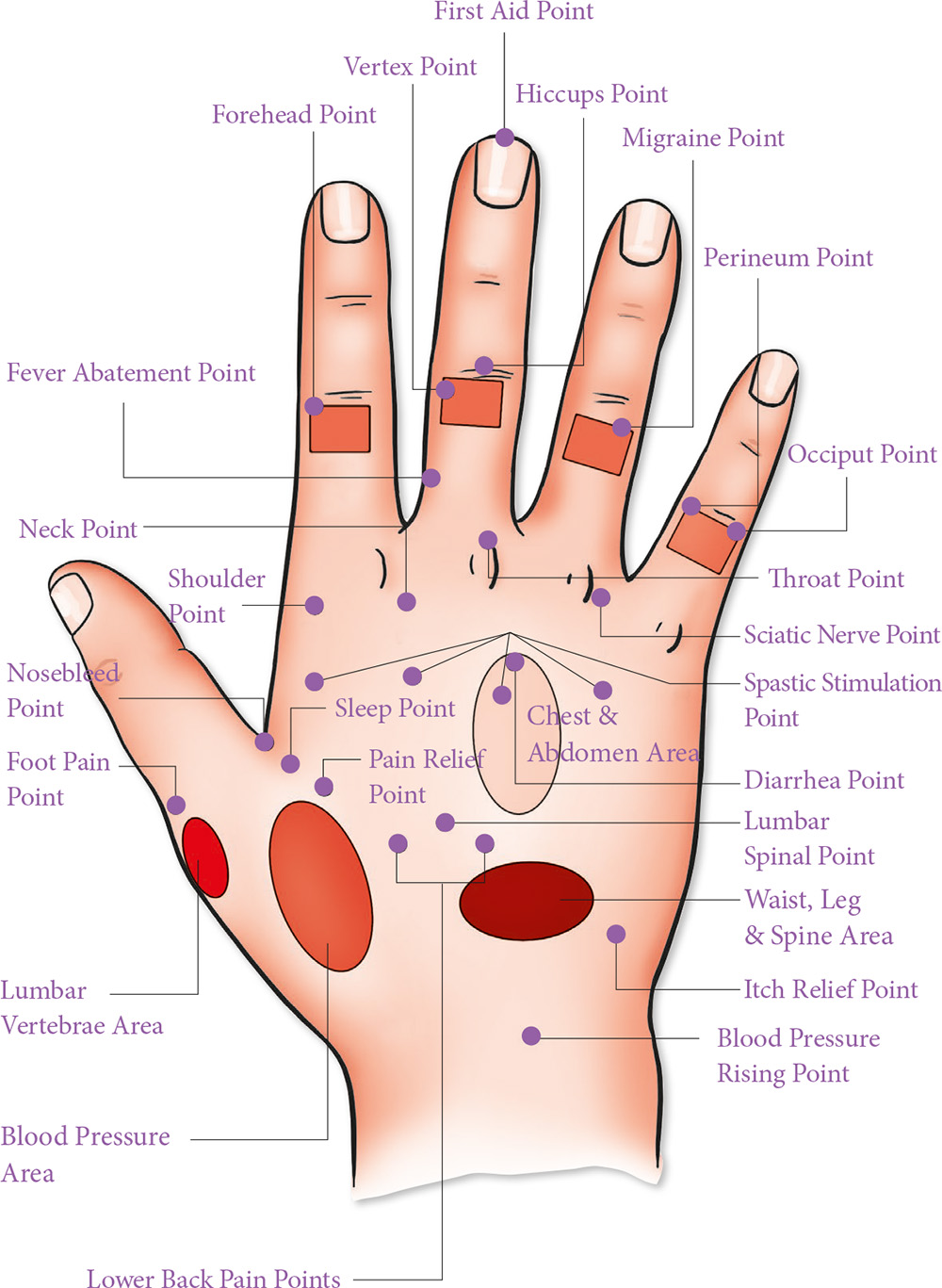Acupoints and Reflex Points and Areas in the Hand
Before explaining hand reflexology or acupressure, this chapter aims to provide readers with a brief introduction to the concepts of the meridian system and the holographic reflex areas in Traditional Chinese Medicine. The two concepts, though belonging to different theoretical systems, are complementary to each other, and play a crucial role in hand reflexology and acupressure, according to TCM.
1. Meridians and Acupoints
As the basis of TCM theory, the meridian system can actually be felt in real life. However, no research has so far found any convincing evidence of its physical form. To put it simply, the meridian system is like a traffic network spreading across the human body, consisting of channels designed exclusively to supply qi (vital energy) and blood to every part of the body. Among them, the principal channels are called jing (meridians), whereas the branching vessels connecting the principal channels and connected with one another are called luo (collateral). Serving the five visceral organs (wuzang) and six bowel organs (liufu), they crisscross the human body, connecting the surface and the depth as well as the top and the bottom as an organic whole. Through the circulation of qi and blood, they provide nutrition to sustain the organic livelihood of the human body.
There are fourteen meridians in the human body. They are:
• Taiyin Lung Meridian of the Hand (LU);
• Yangming Large Intestine Meridian of the Hand (LI);
• Yangming Stomach Meridian of the Foot (ST);
• Taiyin Spleen Meridian of the Foot (SP);
• Shaoyin Heart Meridian of the Hand (HT);
• Taiyang Small Intestine Meridian of the Hand (SI);
• Taiyang Bladder Meridian of the Foot (BL);
• Shaoyin Kidney Meridian of the Foot (KI);
• Jueyin Pericardium Meridian of the Hand (PC);
• Shaoyang Sanjiao Meridian of the Hand (TE);
• Shaoyang Gallbladder Meridian of the Foot (GB);
• Jueyin Liver Meridian of the Foot (LR);
• Conception Vessel (CV);
• Governing Vessel (GV).
The hand is traversed by a large number of meridians. The fingers, as the human body’s upper extremities, are one of the places where blood flow starts to go back into the body. Moreover, meridians pertaining to such organs as the heart, lung, large intestine, the triple energizer (sanjiao) and pericardium (fig. 1) all go through the fingers and have some points there. Therefore, fingers are believed to correspond to the internal organs: The thumb reflects the functions of the lung and the spleen; the index finger the stomach and the intestines; the middle finger the cardiovascular functions; the ring finger the liver and the gallbladder; and the little finger the uterus, testicles, and kidneys.
Massaging related fingers will help to alleviate symptoms of some diseases:
• Taiyin Lung Meridian of the Hand (thumb): For pneumonia, shortness of breath, coughing, tightness of chest, and nosebleeds.
• Yangming Large Intestine Meridian of the Hand (index finger): For abdominal pain, diarrhea, enteritis, toothache, rhinitis, headaches, and anxiety.
• Jueyin Pericardium Meridian of the Hand (middle finger): For chest pain, irritability, tightness of chest, dizziness, and diabetes.
• Shaoyang Sanjiao Meridian of the Hand (SJ) (ring finger): For migraine, vertigo, and indigestion.
• Shaoyin Heart Meridian of the Hand (HT) (little finger): For palpitations, chest pain, and manic syndrome.

Fig. 1 Organs such as the heart, lungs, large intestine, the triple energizer (sanjiao), pericardium, and small intestine all have meridians that pass through the fingers.
• Taiyang Small Intestine Meridian of the Hand (SI) (little finger): For breast pain, ENT diseases, ophthalmological and dental issues, and insufficient breast milk secretion.
Located along the pathways of the meridian and collateral, acupoints are usually places where nerve endings concentrate, or locations where thicker nerve fibers travel. When you feel discomfort or pain, it is the acupoints that send out such signals. The acupoints situated along the pathways of the fourteen principal meridians are called “meridian points.” In addition, there are acupoints in certain fixed location that have special effects for treatment. Those are called “extra-ordinary points.” These acupoints are not isolated on the surface of your skin, but are closely related to organs and tissues deep in your body.
Therefore, in a sense, acupoints reflect problems in your body, and are working points for treating those problems (figs. 2–3):
• Shangyang (LI 1): For toothache, and painful or swollen throat.
• Erjian (LI 2): For cranial nerve injuries, eczema, allergic rhinitis, acute conjunctivitis (or pink eye), and constipation.
• Hegu (LI 4): For chronic gastritis, menstrual cramps, irregular periods, urticaria, and cataract.
• Yangxi (LI 5): For headaches, hearing loss, tinnitus, headache due to reversed upward flow of qi, tightness in the chest and shortness of breath, painful and swollen red eyes, ENT-related diseases, ophthalmological and dental problems, stroke, hemiplegia, and problems with wrist joints and surrounding soft tissues.
• Daling (PC 7): For anemia, hypotension, irritability, and headache.
• Laogong (PC 8): For jaundice, chest pain, tightness in the chest, insomnia, nausea, vomiting, irritability, and restlessness.
• Zhongchong (PC 9): For loss of consciousness, sun stroke, faintness, nocturnal fretfulness in infants, and stiffness, swelling and pain in the tongue.
• Guanchong (TE 1): For indigestion in infants.
• Zhongzhu (TE 3): For nosebleeds, gingivitis, facial paralysis, trigeminal neuralgia, abdominal sounds, and toothache.
• Yangchi (TE 4): For loss of hearing and unquenchable thirst.
• Shenmen (HT 7): For irritability, fretfulness, insomnia, anemia, and hypotension.
• Shaochong (HT 9): For palpitations, chest pain, manic syndrome, and coma.
• Shaoze (SI 1): For breast pain, ENT diseases, ophthalmological and dental problems, and insufficient breast milk secretion.
• Qian’gu (SI 2): For headache, pain in the eye and ear, painful and swollen throat, insufficient breast milk secretion, and heat pathogen diseases.
• Houxi (SI 3): For loss of hearing, manic syndrome, and malaria.
• Wan’gu (SI 4): For diabetes and cholecystitis.
• Yanggu (SI 5): For tinnitus, stomatitis, parotitis (mumps), and epilepsy.
• Yanglao (SI 6): For myopia, stiff neck, mental and neurological disorders, and sequelae of cerebrovascular disease.

Fig. 2 Acupoints on the back of the hand.
• Lieque (LU 7): For coughing, shortness of breath, painful and swollen throat, headaches, toothache, and Bell’s palsy.
• Yuji (LU 10): For chronic bronchitis and tonsillitis.
• Taiyuan (LU 9): For colds, shortness of breath, chest pain, painful and swollen throat, and allergic rhinitis.
• Shaoshang (LU 11): For pharyngitis, acute pneumonia, high fever, and difficulty breathing.

Fig. 3 Acupoints in the palm of the hand.
2. Reflex Points and Areas
Hologram theory in TCM draws on hologram science, bio-hologram theory, and traditional Chinese theories. It combines both Western and Chinese medical sciences, and offers a window into the developments of the human body in a dynamic and straightforward manner.
Hologram theory holds that a human body is an organic whole. Any changes in physiological functions, and pathological changes in a local organ will have an impact on the overall function and pathological state of the human body. An imbalance of overall function will inevitably affect all of the organs. Therefore, when treating a disease in a local organ, we should make an effort to tune the overall balance of the body. When treating systemic diseases, we should try to stimulate local organs as well. There are many holographic reflex areas and points in the hand that pertain to the internal organs and tissues of the human body. These reflex areas play a unique and independent role in addition to the meridian points and extra-ordinary points.
According to hologram theory, stimulating the reflex points and areas in the hand can prevent or heal some diseases. The movements provided by the two hands will transmit positive stimulation to the organs, balance the yin and yang, and promote the circulation of qi and blood, which in turn will boost physical fitness.
The following are some examples of reflex areas in the hand (fig. 4), elucidating the positive effects each reflex area has on specific diseases.
• (Light blue area) Chest & respiratory organs: For cold, asthma, coughing, painful and swollen throat, congested nose.
• (Red area) Stomach, spleen & large intestine: For loss of appetite, acne, obesity, acute and chronic enteritis.
• (Dark pink area) Reproduction: For abnormal menstruation, menopause syndrome, spermatorrhea, sexual dysfunction.
• (Green area) Ear & throat: For laryngeal foreign bodies, otitis media, vertigo.
• (Yellow area) Palm: For neurasthenia, insomnia, autonomic nerve disorders.
• (Light pink area) Essence & heart: For heart disease, insomnia, difficulty breathing.
• (Dark green area) Gastrointestine: For loss of appetite, indigestion, diarrhea.
• (Dark blue area) Foot & leg: For lower back pain, leg pain, foot pain.
• (Purple area) Palm center: For aversion to cold, anemia, carsickness, loss of appetite.
• (Orange area) Liver & gallbladder: For diseases of the liver and the gallbladder, toothache, headache, eye fatigue, urticaria.
The hand’s reflex points and areas all play roles in alleviating the symptoms of specific diseases. For example, massaging the heart point will relieve symptoms of headache and anxiety; massaging the kidney point will alleviate symptoms of toothache, and diseases of the kidney and the bladder; massaging the cough & asthma point will help ease asthma and coughing.
The reflex points and areas located on the side and the back of the hand (figs. 5–6) all have an impact on specific organs and diseases, which are explained later in the book. In the subsequent chapters, we will explain how to alleviate the symptoms of diseases by massaging the related points and areas as suggested by acupoints in TCM and the theory of holographic reflection.

Fig. 5 Reflex points of the fifth metacarpus.

